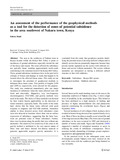| dc.contributor.author | Dindi, Edwin | |
| dc.date.accessioned | 2015-03-05T08:28:08Z | |
| dc.date.available | 2015-03-05T08:28:08Z | |
| dc.date.issued | 2014-08 | |
| dc.identifier.citation | Dindi, Edwin (2014). An assessment of the performance of the geophysical methods as a tool for the detection of zones of potential subsidence in the area southwest of Nakuru town, Kenya. journal of Environmental Earth Sciences, | en_US |
| dc.identifier.issn | 1866-6299 | |
| dc.identifier.uri | http://link.springer.com/article/10.1007/s12665-014-3647-1 | |
| dc.identifier.uri | http://hdl.handle.net/11295/80969 | |
| dc.description.abstract | The area to the southwest of Nakuru town in Kenya located within the Kenya Rift Valley is prone to incidences of ground subsidence especially toward the end of the heavy rain season. The zones affected by subsidence are typically linear, trending approximately north–south conforming to the structural trend of the Kenya Rift Valley. These ground subsidence incidences have in the past led to collapse of houses and damage to roads that happen to be located above the affected linear zones. This study set out to investigate the potential of geophysical methods to delineate these linear zones. Two profiles of lengths 2,430 and 2,850 m, respectively, were selected for this purpose. The study was conducted immediately after one major incidence of subsidence when the zones affected were still fresh and observable. Magnetics, very low-frequency electromagnetics (VLF-EM), and gravity methods were used in the study. The choice of these methods was dictated by their widely known applicability in the detection of linear structures, especially faults. The results of the study have shown that the linear zones affected yield good response to magnetic and VLF-EM methods. Anomalies similar to those detected across fresh subsidence zones were also detected at locations where there was no surface expression of subsidence, suggesting that the latter locations are potential zones of future subsidence. Further, there were locations along the profile that were without any anomalies. The relatively low sensitivity of the zones to the gravity method is attributed to the very narrow nature of these zone and hence limited low-density material to generate appreciable negative gravity anomalies. It is concluded from this study that geophysics permits identifying the potential areas to develop surficial collapse and to identify sectors that are potentially dangerous because they present similar signatures as the sectors with surficial evidence and sectors without anomalies. The sectors without anomalies are interpreted as having a different subsoil structure to that with sinkholes. | en_US |
| dc.language.iso | en | en_US |
| dc.publisher | University of Nairobi | en_US |
| dc.title | An assessment of the performance of the geophysical methods as a tool for the detection of zones of potential subsidence in the area southwest of Nakuru town, Kenya | en_US |
| dc.type.material | en_US | en_US |

